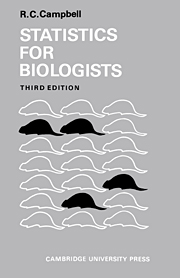Book contents
- Frontmatter
- Contents
- PREFACE
- PREFACE TO SECOND EDITION
- PREFACE TO THIRD EDITION
- 1 WHAT IS STATISTICS ABOUT?
- 2 PRESENTING THE INFORMATION CONTAINED IN ONE SAMPLE
- 3 COMPARING SEVERAL SAMPLES
- 4 ASSOCIATION
- 5 CHOOSING BETWEEN ACTIONS
- 6 THE NORMAL DISTRIBUTION
- 7 THE NORMAL VARIABLE IN EXPERIMENTS AND SURVEYS
- 8 ASSOCIATED NORMAL VARIABLES
- 9 SOME NON-NORMAL DISTRIBUTIONS
- FURTHER READING
- REFERENCES
- APPENDIX: TABLES AND FIGURES FOR STATISTICAL TESTS AND EXERCISES
- INDEX
PREFACE TO THIRD EDITION
Published online by Cambridge University Press: 05 June 2012
- Frontmatter
- Contents
- PREFACE
- PREFACE TO SECOND EDITION
- PREFACE TO THIRD EDITION
- 1 WHAT IS STATISTICS ABOUT?
- 2 PRESENTING THE INFORMATION CONTAINED IN ONE SAMPLE
- 3 COMPARING SEVERAL SAMPLES
- 4 ASSOCIATION
- 5 CHOOSING BETWEEN ACTIONS
- 6 THE NORMAL DISTRIBUTION
- 7 THE NORMAL VARIABLE IN EXPERIMENTS AND SURVEYS
- 8 ASSOCIATED NORMAL VARIABLES
- 9 SOME NON-NORMAL DISTRIBUTIONS
- FURTHER READING
- REFERENCES
- APPENDIX: TABLES AND FIGURES FOR STATISTICAL TESTS AND EXERCISES
- INDEX
Summary
The main object of the new material in this edition is to illustrate the potential usefulness of computers to the biologist when he or she needs to undertake statistical analyses; to this end I have given computer analyses of a selection of the examples in the text and exercises, using several different statistical languages. I have not attempted to illustrate all the languages available nor to introduce all the facilities of the chosen languages which could be applied even to the limited range of examples in this book. To achieve this would demand a very large book on those topics alone, a book moreover which would be out of date before it was published.
The biologist who wishes to use a statistical language on a computer should be prepared to seek local advice about the facilities available and to go on seeking help as difficulties are encountered in applying the chosen language: but I hope that the examples in this book will show something of what can reasonably be looked for and encourage the reader to make the effort that will be necessary to gain some facility in the use of the very powerful tools that these languages offer.
In incorporating the new material I have tried to disrupt the existing text as little as possible. In particular, I have been careful not to reduce the—sometimes lengthy—existing explanations of how calculations are built up, because I believe that understanding these processes is an important part of comprehending the statistical methods: this comprehension is no less necessary just because we can use a computer to undertake the labour of the calculations.
- Type
- Chapter
- Information
- Statistics for Biologists , pp. xvii - xviiiPublisher: Cambridge University PressPrint publication year: 1989



